3/2/1962 - Growing more mythical with each passing year (to the point where thousands and thousands of fans will eventually claim to be at Hershey Sports Arena (a band-box gym smelling of chocolate originally built to house the local hockey team) in Hershey, Pennsylvania on the historic evening), 4,124 fans are on-hand (capacity is roughly 8,000 people) when 7'1" center Wilt Chamberlain scores an unprecedented 100 points (still the NBA record for most points in a single regular season or playoff game) for the Philadelphia Warriors against the New York Knicks in a game that the Warriors win, 169-147.
After
Born on August 21, 1936 in Philadelphia, Pennsylvania to the large family (there will be nine children altogether) of domestic worker Olivia Ruth Johnson and welder, custodian, and handyman William Chamberlain, the youngster that will one day be known as "Wilt the Stilt," "Goliath," and "The Big Dipper" (his personal favorite), Wilton Norman Chamberlain is at first a very frail child, almost dying of pneumonia and so sick that he misses a full year of schooling. But once he gets healthy (his six feet tall at the age of 10, and 6'11" when he enters Philadelphia's Overbrook High School), he grows into one of the country's finest athletes. Thinking basketball is "a game for sissies," he first shows his physical prowess for sports by becoming something of a black Jim Thorpe in track and field ... he high jumps 6'6", runs the 440 in 49.0 seconds, runs the 880 in 1:58.3, puts the shot 53'4", and long jumps 22'. But at the time, basketball is king in Philadelphia and eventually Chamberlain decides to give the game a try ... a try that changes the way the game, and the position of center is played.
4th Grade - Can You Find Wilt?
At Overbrook High
With Coach Cecil Mosenson
At Overbrook High, the huge Panther average 31 points per game for the 1953 season. Winning the Public League title, Overbrook finishes second for the Philadelphia city championship, losing to the eventual champion, West Catholic, 54-42 (in the game, Chamberlain is quadruple-teamed, and yet scores 29 of his ream's 42 points). And that is just first year! In his second season for Overbrook, Chamberlain sets a city record by scoring 71 points in a game against Roxborough High, guides the Panthers to a 19-0 record in which the squad beats South Catholic for the city title with Wilt scoring 32 in the championship game. In his third season for the Panthers, Chamberlain continues to tear his opponents apart, scoring 74, 78, and 90 points in three consecutive games (after the 90 game, the Philadelphia Inquirer states that Chamberlain might have scored 100 points if he'd played the entire 32 minutes of the game), the team wins its third Public League title, its second city title beating West Catholic 83-42 (he scores 35 in the game), as Wilt ends his Overbrook career with three league championships, two city championships, a 56-3 record and breaks the high school scoring record of Tom Gola with 2,252 points, averaging 37.4 points a game. Noticed by all the big college basketball programs (more than 200 schools will try to recruit the talented center), not wanting to play for a southern school because of the myriad of racial issues haunting the region at the time, and wanting to escape big city living and the East Coast, Chamberlain selects Kansas for his college matriculation (it is said that UCLA offers to find him work in Hollywood if he chooses the Bruins, and that to get him to stay home, the University of Pennsylvania offers him diamonds and a position for his high school coach if he will play for the Quakers).
Freshman unable to play on the varsity at the time, Chamberlain stars on the freshman team led by legendary coach, Phog Allen (at Kansas, he will win 24 conference championships and three national titles). In his first game at Kansas, in a game against the varsity squad (a group favored to win yet another conference championship), Chamberlain leads the freshman to victory while scoring 42 points, grabbing 29 rebounds, and blocking four shots. Despite the retirement of Allen following the 1955 season, Chamberlain makes his debut at center for the Kansas Jayhawks on December 3, 1956; a contest in which he breaks two Kansas basketball records by scoring 52 points and hauling in 31 rebounds.in a 87-69 triumph over Northwestern. Successful despite being double and triple teamed in every game and having many coaches run stalls at the Jayhawks (the shot clock will not become a constant of NCAA games until 1984), Chamberlain leads the team to a meeting with the North Carolina Tar Heels of Hall of Fame coach, Frank McGuire (there are 23 teams in the field). In the championship game, McGuire has his smallest starter, 5'11" guard Tommy Kearns, jump tip-offs against Chamberlain just to mess with the big man's mind, triple-teams the center with one man behind him, one in front, and a third rushing into the coverage once Wilt receives the ball, and stalls for significant periods of time ... with Kansas shooting only 27% from the field, the Jayhawks trailed North Carolina, 29-22 at halftime, but catch the Tar Heels at 46-46 when regulation play ends, despite a ten minute stall by McGuire with the game in his favor at 40-37. In the first overtime, both teams score only two points, in the second overtime North Carolina gets the ball and stalls for the entire extra period, and in the third overtime stanza, the teams swap the lead. Trailing 54-53 with ten seconds left to go, Kansas sets up for a potentially game winning shot by Chamberlain, but loses the game when Ron Loneski's pass into the low post is intercepted (North Carolina will finish the season at 31-0, while Kansas completes it's season with a 24-2 record). A devastating loss for Chamberlain, he nonetheless has 23 of his team's points, grabs 14 rebounds, and is named the Final Four's Outstanding Player of the tournament (he is also named to NCAA's first team basketball squad for the year, and should anyone forget that he is more than just a basketball player, for the Jayhawk's track and field varsity, he runs the 100 yard dash in 10.9 seconds, hurls the shot-put 56 feet, triple jumps over 50 feet, and thrice, takes the conference title in the long jump event). In Chamberlain's junior season at Kansas, Wilt is again named an All-American as he leads the Jayhawks to an 18-5 record (he misses three of the losses due to a urinary tract infection) while averaging 30.1 points a game. Sadly for the squad though, the team finishes in second period during a time period in which the NCAA invites only conference champions to its championship tournament and after a junior season in which he has taken a monstrous amount of racial insults from opposing fans, has too frequently batted heads with Allen's replacement, Coach Dick Harp, and has the fun of the game taken away by triple-teams and stalls, he decides to leave Lawrence and amateur play behind by turning professional (already profiled in Time, Look, Newsweek, and Life by the time he turns 21, Wilt receives $10,000 dollars for the article he writes for Look, entitled, "Why I'm Leaving College," during a period in which pro basketball players are only making about $9,000 a year), signing with the Harlem Globetrotters for the 1958-1959 season for $50,000 (at the time, NBA teams will not sign players until their college class graduates).
Surrounded By Tar Heels
Kansas
Globetrotter
College class graduated, Chamberlain becomes the highest paid player ($30,000) in the NBA, playing for his hometown team, the Philadelphia Warriors, in 1959. As before at the high school, college, and with the Globetrotters, he immediate becomes a dominating presence in the league. In his very first game against the New York Knicks, the rookie center scores 43 points and takes down 28 rebounds. in game #3 against the Syracuse Nationals, he gets 41 points and 40 rebounds, in his fourth game he plays against the reigning champion Boston Celtics for the first time and throws down 30 points against Hall of Fame center, Bill Russell, playing the Knicks again, he scores 39 points and ups his single game high for rebounds to 43, then as the season moves into 1960, he gets 58 points, 42 rebounds, and 4 assists in a game against the Detroit Pistons. For his rookie NBA season, Chamberlain averages 37.6 points and 27 rebounds a game, breaking the rookie and regular season scoring records (he will set 8 NBA records in his first year), wins the Rookie of the Year Award, wins the NBA MVP, is on the winning team for the NBA All-Star game, is the MVP of the All-Star game (with a 23 point, 25 rebound performance), and leads the Warriors to the championship series against the Boston Celtics (which the Celtics take 4 games to 2, despite a game in which he becomes the only player thus far to get 50 points and 35 rebounds in a playoff game) ... he also faces constant double and triple teaming defenses, takes a hammering of hard fouls (along with those the officials miss), and shows he is vulnerable at the free throw line, shooting barely 50% at the line. In his second year, Chamberlain just gets better, besting all his rookie year stats, becoming the first player to score over 3,000 points in a season (the only other player to score as much will be Michael Jordan in 1987), and getting over 2,000 rebounds, breaking the season mark there too, and he moves his own single game rebounding record to 55. And then the 1960-1961 season begins and Chamberlain posts and even finer year. Coached now by the man who ruined his chance for a NCAA championship, Frank McGuire, Chamberlain puts together a year in which he averages 50.4 points and 25.7 rebounds a game, becoming the first and only player to score 4,000 points in a season. Incredibly, he plays 48.53 minutes a game and is in 3,882 minutes of the Warriors 3,890 minute long season! And on a cold, rainy night in Pennsylvania, he puts down an almost perfect game.
All-Star
Finger Roll
Putting down games in which he scores 67, 65, and 61 points, in an triple overtime game against the Los Angeles Lakers (the only NBA team at the time located west of the Mississippi River), he breaks forward Elgin Baylor's sine game point record of 71, with a 78 point performance and the rumbling begins over what Chamberlain might do someday. Baylor says he doesn't mind having his record broken, because someday Chamberlain is going to score 100 and Bill Russell states that Chamberlain has the size, speed, and talent to score 100 some night ... and they are right. With only five games remaining in the regular season though, no one is expecting fireworks out of the Friday night game in Hershey between the second place Warriors (eleven games behind the first place Boston Celtics) and the last place Knicks. Treating the contest as just another game (no members of the New York press corps even attend the game and no known film of the game exists, two still photographer's are sent to the game), the night before, Chamberlain is in New York City, partying all night with a female friend (in his autobiography he will claim to have pollinated 20,000 women ... a tale for another time) he drops off at her home at 6:00 in the morning. With no sleep and suffering from a hangover, he takes the 8:00 a.m. train to Philadelphia, meets friends at the Philly train station and then has lunch with them, barely making the team bus to Hershey. Still struggling to establish itself as a major sport in it's 16th season, most of the fans that show up for the game are actually there for a preliminary exhibition basketball game between players from the NFL's Philadelphia Eagles and the Baltimore Colts. Knicks regular center, 6'10" Phil Jordon from Whitworth University in Spokane, Washington, out with the flu (though there will be rumors that he is suffering from a monster hangover), Chamberlain will be opposed by second year player, 6'10" center Darrall Imhoff (an NCAA champion in 1959 with the California Golden Bears, and a member of the Olympic gold medal basketball team of 1960 that also includes Walt Bellamy, Bob Bozer, Terry Dishinger, Jerry Lucas, Oscar Robertson, and Jerry West), backup power forward, 6'9" Cleveland Buckner, and 6'6" forward, Dave Budd.
Hershey Sports Arena
Imhoff
Buckner
Not intending to go after any kind of records, Chamberlain makes his first five shots as the Warriors open up a 19-3 lead, and when the quarter ends, the Knicks trail 42-26, with Chamberlain having 23 points, including going 9-for-9 on his free throws (McGuire has converted Chamberlain into shooting his free throws underhanded). By halftime, the Warriors lead over the Knicks is at 79-68, Chamberlain has 41 points, and Imhoff is in foul trouble (believing Chamberlain is getting preferential treatment, after one foul, Imhoff screams at the officials, "Well, why don't you just give the guy a hundred now and we'll all go home!"). Having already scored 60 points or more in 15 previous games, there is still no thought of Chamberlain going for 100, but the door to that destination opens in the locker room when future Hall of Fame point guard, 6' Guy Rodgers (passing the ball to Chamberlain, the guard will record 20 assists for the game) goes to McGuire and tells the coach, "Let's get the ball to Dip. Let's see how many he can get." Plan agreed to by their coach, the Warriors keep feeding the ball to their Hall of Fame center, and when the third quarter ends, Wilt has pushed his scoring total 69 and realizes he has a chance to beat his own personal bests of 71 (for a regulation game) and 78 (for an overtime contest). Dunks, fadeaway jumper, finger rolls, free throws ... everything is working for Chamberlain as he beats up on Imhoff (before fouling out, the center will score 7 points and have 6 rebounds), Buckner (the forward will score 33 points and 8 rebounds in 33 minutes of play), Budd (13 points and 10 rebounds) and any other Knick trying to stop him. Stirring up the crowd, arena announcer David Zinkoff begins calling out Chamberlain's point total after every basket by the center and the crowd is soon chanting "Give it to Wilt!" over and over until the end of the game. With eight minutes to go in the game, Chamberlain needs 25 points to reach 100, a pace that for a regulation would have him scoring 150 points. No problem for the Big Dipper ... with 7:51 left in the game, Chamberlain establishes a new best for a single game when he scores his 79th point of the game. Team ball be damned now in pursuit of an incredible record, the Warriors support Chamberlain completely and continue feeding him the ball (at one point, guard Al Attles passes up an easy layup so that Wilt can get his 88th and 89th points), while in opposition, the Knicks, trying to prevent Chamberlain from reaching his goal, play as slow as possible when they have the ball, and begin fouling Warriors not wearing Wilt's #13! With five minutes left to go, responding to the strategy of the Knicks and safely in the lead, McGuire surrounds Chamberlain with bench players so that they can get the ball back by fouling Knicks and then toss it into Chamberlain afterwards for more scoring by the big man (for the game, the Warriors will foul 25 times, while the Knicks are whistled for 32 fouls, with both Imhoff and 31-point scoring forward, 6'6" Willie Naulls from UCLA, fouling out of the game). With 2:12 left in the game, Chamberlain gets his 94th point, then scores on a fadeaway jumper to hit the 96 point mark, and then with an emphatic dunk (off a lob pass from guard York Larese), reaches 98 points scored as the crowd goes crazy.
Time for the record running out, with about a minute left in the game, Chamberlain sets up in the lane as forward Joe Ruklick passes the ball to Rodgers, who passes it to Wilt ... who misses his shot, but has the ball rebounded by teammate Ted Luckenbill. Luckenbill in turn passes the ball back to Chamberlain, who misses his second shot at immortality. Luckenbill to the rescue again with another rebound (he will only have the two for the game), the forward passes the ball to Ruklick, who passes up a layup to lob the basketball back to Chamberlain. Surrounded by five smaller Knicks, Chamberlain gets the ball, leaps in the air, and sends a dunk into the basket that scores point 100 with 46 seconds remaining in the contest. 100! As the crowd explodes, with over 200 fans running on to the floor to congratulate and touch the Big Dipper, Ruklick goes to the scorer's bench to make sure he receives credit for the assist on the record basket. After the officials clear the fans from the floor (it takes nine minutes), the game ends with Ruklick missing two foul shots on purpose (so that Wilt might have a chance at 102 points), while Wilt stands motionless in the mid-court circle, done for the evening believing 100 points sounds better than 102. Game concluded, along with Chamberlain's record of 100 points (still the record, the closest anyone has come so far is Los Laker Kobe Bryant's 81 points against Toronto in 2006 when he shoots 28-46 from the field and makes 18 of 20 free throws), records will also be set for most free throws made in a game by a player (28 for 32 ... tied by Adrian Dantley in 1984), most points scored by two teams in a regular season game (316 ... still the record), most field goals by two teams in one game (120) most shot attempts from the field by a player (63 ... still the record), most shots made (36 ... still the record), most points in a quarter (31 ... broken by David Thompson's 32 in a 1978 game in which the forward gets 73), most shots in a quarter (21), most points scored in a half (59 ... still the record), most field goals in a half (22), most shots in a half (37) ... and of course, Chamberlain plays all 48 minutes of the game. It is truly an amazing game and performance, and it's importance echoes to this day (playing the Warriors again at Madison Square Gardens on March 4, 1962, Imhoff, thought to be the goat of the game for allowing Chamberlain's 100 point performance (despite his fouling out of the game and only playing 20 minutes), receives a standing ovation from Knick fans when he "holds" Chamberlain to 55 points in the team's rematch).
Ruklick & Chamberlain
Coming Off The Court
Locker Room
Trying to stay alive, the game is a turning point in professional basketball being accepted as a major league sport that can hold it's own with football, baseball, and hockey. As Hall of Fame guard Oscar Robertson will state, "People heard about Wilt scoring a 100, averaging 50 a night, and they wanted to see the guy do it ... I believe Wilt Chamberlain single-handedly saved the league" (others are not so thrilled with the game, Hall of Fame player and coach, Richie Guerin, who scores 39 in the game for the Knicks, felt the Warriors and Chamberlain break an unwritten code of conduct by embarrassing their opponent and trying to set a record outside the normal flow of a game, while his coach, Eddie Donovan is more succinct, stating simply, "The game was a farce."). And as if giving truth to Robertson's statement, two days after the game, Chamberlain appears on the Ed Sullivan Show, while for years while he is the commissioner of the NBA, when someone calls Daniel Stern's office and is put on hold, they hear the radio call of Bill Campbell on Wilt making his last field of the game, "He made it! He made it! He made it! A Dipper Dunk!" ... a bit of basketball and radio history that in 2016 is added to the National Recording Registry for it's "cultural, artistic, and/or historical significance to America society and the nation's aural legacy" (only the fourth quarter call exists). And the ball with which Chamberlain scores his 100th point of course becomes magical ... 14-year-old Kerry Ryman, an attendee at the game, claims Wilt gives him the special basketball, which is put up for auction by Leland's Auction in 2000, with a starting asking price of $551,844, but because of authenticity issues (in the form of Al Attles claiming Chamberlain gave him the actual 100 point ball), sells for "only" $67,791.
Campbell
The Ball
As for Wilt, he goes on to other milestones and honors (his favorite game of his career is a 1960 game in which he sets the NBA record for rebounds in a single game by grabbing 55 against his Boston Celtics nemesis, Hall of Fame center Bill Russell) in a NBA playing career that lasts from 1958 to 1973 in which the Big Dipper scores 31,419 points (a 30.1 average), pulls down 23,924 rebounds (a 22.9 average), and 4,643 assists ... two world championships (one with the Philadelphia Warriors and one with the Los Angeles Lakers in which he will be voted the Finals MVP), four NBA MVP awards (1960, 1966-1968), thirteen NBA All-Star game appearances (he is the MVP of the 1960 contest), first-team All-NBA seven times (and he is second team three times), first-team All-Defense twice, seven NBA scoring championships, eleven times he leads the league in rebounding, nine times he leads the league in minutes played (he never fouls out of any regular season game), leads the league in assists in 1968, is picked as a member of the NBA 35th, 50th, and 75th Anniversary teams, and his #13 retired by the Golden State Warriors, Philadelphia 76ers, and the Los Angeles Lakers (and of course he is inducted into the Naismith Memorial Basketball Hall of Fame in 1978). When he retires, Chamberlain has records for most points scored in a game and a career, the same for rebounds, and is the only player to average 30 points and 20 rebounds for a season, a feat he pulls off seven times, and he is also the only one to average 30 points and 20 rebounds for his entire career (and he has a huge influence on how the game is played, his size and success forcing changes that widen the lane around the basket, make it illegal to inbound the ball by tossing it over the backboard, and forcing a free throw shooter to stay behind the foul line (to prevent Wilt from dunking the ball from that distance).
Playing Against Russell In 1966
1972 - The Los Angeles Lakers
First Championship
And after the NBA, Chamberlain does not slow up at all. For a single season, Chamberlain is the coach of the ABA's San Diego Conquistadors (going a mediocre 37-47) before deciding to move to greener pastures (and promote his latest book, the autobiography, "Wilt: Just Like Any Other 7-Foot Black Millionaire Who Lives Next Door. No more basketball, Wilt becomes a successful businessman and makes money in real estate and stocks, invests in bloodmares, buys a popular Harlem nightclub that he names "Big Wilt's Smalls Paradise, sponsors professional volleyball and track and field teams, appears in ads for TWA, American Express, Volkswagen, Drexel Burnham, Le Tigre Clothing, and Foot Locker, becomes a board member and then president of the newly created International Volleyball Association and plays occasional matches for the league's Seattle Smashers (playing in the league's all-star game so it will be televised, Chamberlain is declared the MVP of the match) and is voted into the International Volleyball Hall of Fame, establishes Wilt's Athletic Club to support a number of athletes in their quests to win Olympic gold (among the Club's members are sprinter Florence Griffith, Greg Foster, Andre Phillips, Alice Brown, and Jeanette Boldin), takes on Arnold Schwarzenegger's Conan as the villain Bombaata in 1984's Conan the Destroyer, attends Martin Luther King's funeral with former president Richard M. Nixon (what a difference a few decades make ... Chamberlain denounces the Black Panthers and other black nationalist groups and considered himself a Republican), turns down offers to play for the Cleveland Cavaliers when he is 45, and for the New Jersey Nets when he is 50 (it is said that in Magic Johnson's rookie year with the Los Angeles Lakers that Chamberlain humiliates the Hall of Fame guard in a one-on-one contest after a team practice), runs marathons, collects cars that include a Ferrari, a Bentley, and custom made Le Mans-style racing he calls Searcher One that has a value of $750,000 in 1996, builds a million dollar mansion in Bel-Air he names "Ursa Major" that has a pivoting 2,200 pound door, no right angles, and an X-rated room that features mirrored walls and a fur-covered waterbed, writes a 1997 book critical of the NBA and its latest players entitled, "Who's Running the Asylum? Inside the Insane World of Sports Today," and at the time of his death is writing a bio-pic screenplay about his life for NCH Entertainment. Never another, after dental surgery the week before, the big man passes away at his Bel-Air home at the age of 63 on October 12, 1999 as a result of congestive heart failure.
Bombaata
At His Nightclub
At Home For Life Magazine
3/2/1962 ... Wilton Norman Chamberlain becomes the only man to get 100 points in a single NBA contest!
.
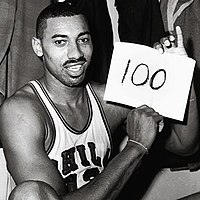








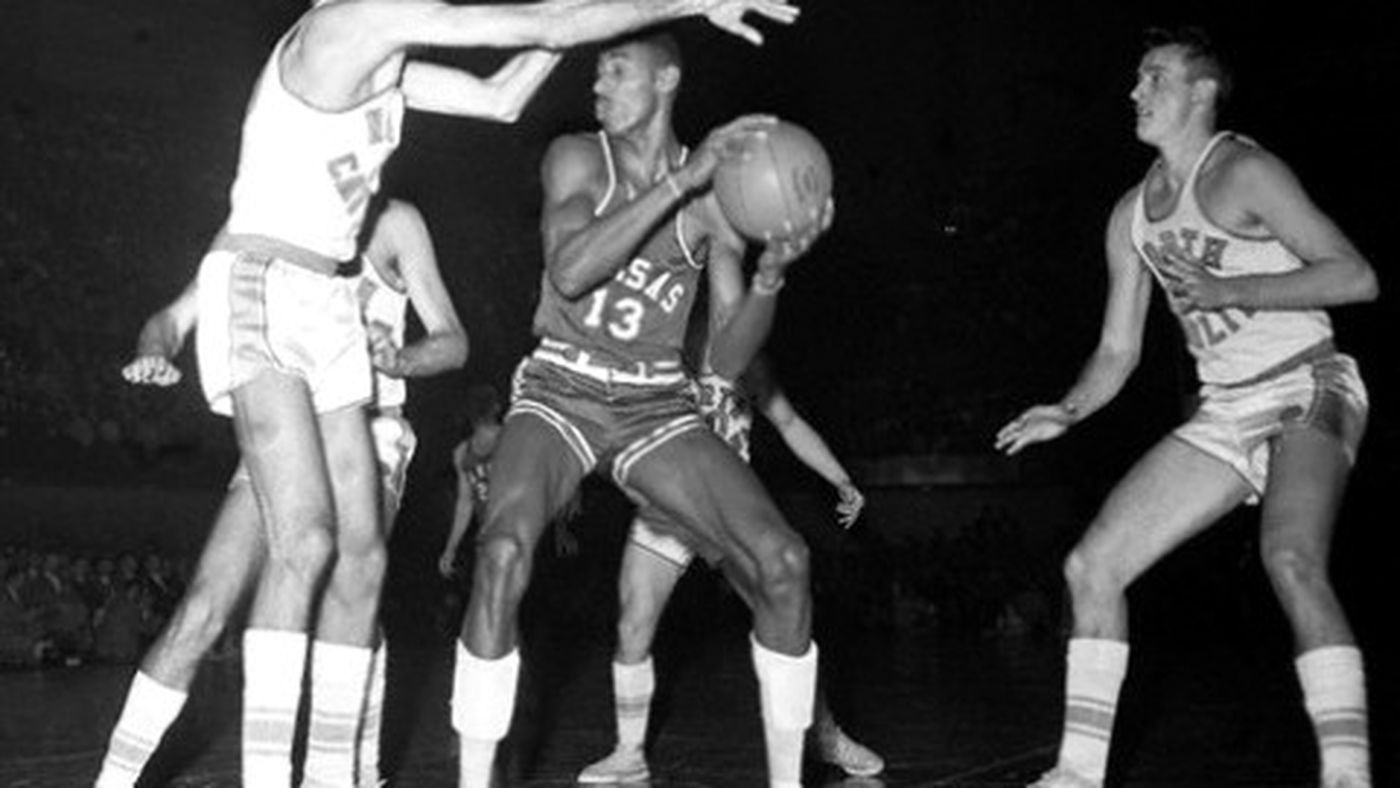











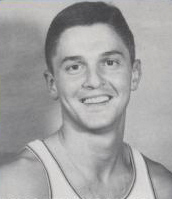


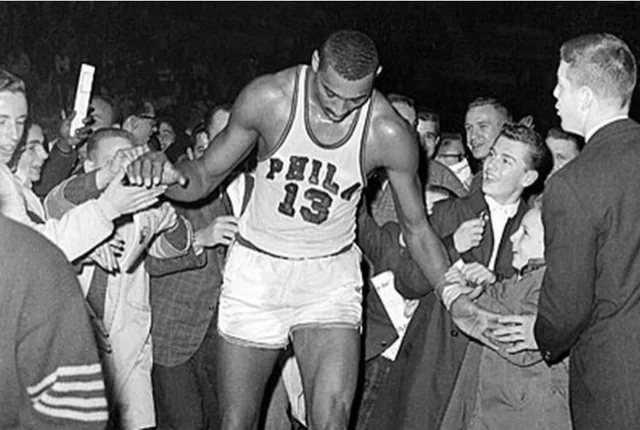




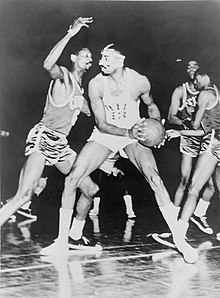





No comments:
Post a Comment